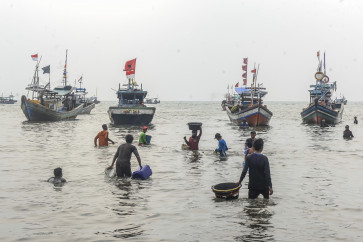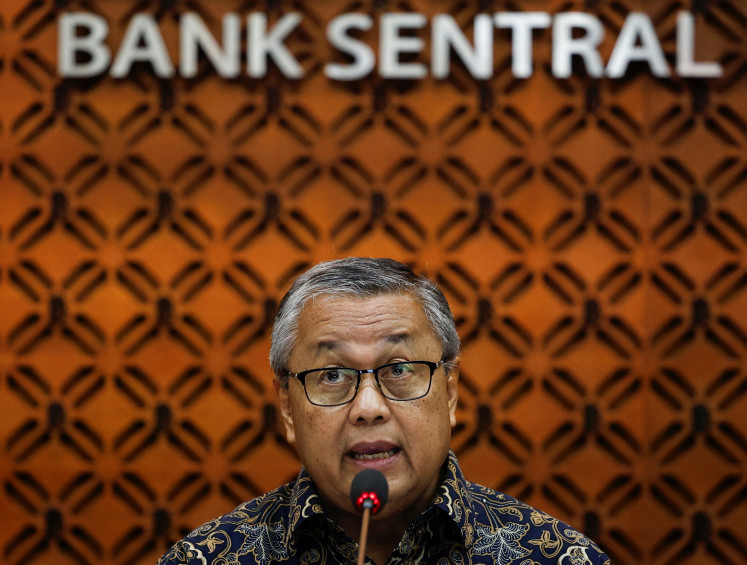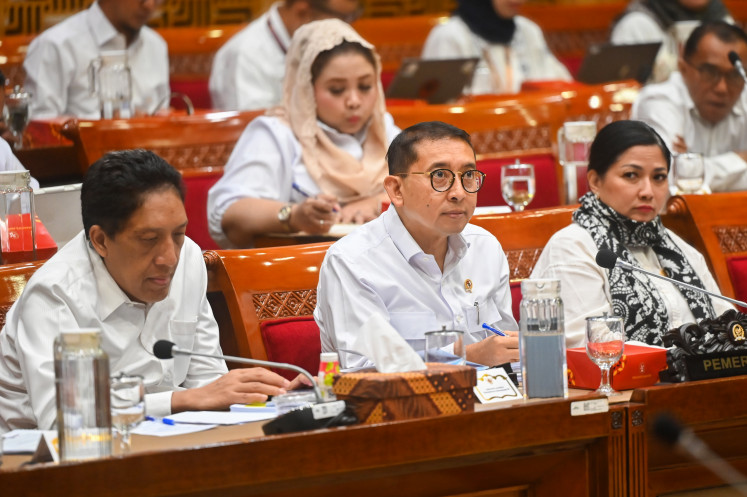Popular Reads
Top Results
Can't find what you're looking for?
View all search resultsPopular Reads
Top Results
Can't find what you're looking for?
View all search resultsIndonesian heritage: at Amsterdam's Rijksmuseum
The Capture of Diponegoro by Lieutenant General Baron De Kock by Nicolaas Pieneman (Courtesy of the Rijksmuseum Amsterdam)Indonesia and the Netherlands share centuries of colonial history, which can be traced in the grand chambers of Hollandâs premier museum
Change text size
Gift Premium Articles
to Anyone
![The Capture of Diponegoro by Lieutenant General Baron De Kock by Nicolaas Pieneman (Courtesy of the Rijksmuseum Amsterdam)" height="385" border="0" width="510"><span class="caption"><em>The Capture of Diponegoro by Lieutenant General Baron De Kock by</em> Nicolaas Pieneman (Courtesy of the Rijksmuseum Amsterdam)</span></span></p><p>Indonesia and the Netherlands share centuries of colonial history, which can be traced in the grand chambers of Hollandâs premier museum. Curator Harm Stevens highlights this journey in his new book <em>Bitter Spice.</em></p><p>âIt is tempting to imagine a young Mohammad Hatta, a student at Rotterdam University starting 1921, visiting the Rijksmuseum, standing in front of Pienemanâs painting [of the capture of Prince Diponegoro]. [⦠] The text next to the painting reads: âThe submission of chief rebel Diepo Negoro to Lieutenant General De Kock. End of the war on Java, 1825-1830â.â Hatta later became Indonesiaâs first vice president.<br><br>Passages like the one above are abundant in Rijksmuseum history curator Harm Stevensâ book <em>Bitter Spice</em>, launched in early November.<br><br>Through the museumâs collection, Stevens attempts â with velvet gloves â to trace the two countriesâ shared history of blood and tears, but also of art and everyday life.<br><br>The Dutch arrived in the Indonesian archipelago at the end of the 16th century, and ended up colonial rulers until World War II. At the end of the war, Indonesia declared its independence in August 1945, then entering a four-year armed conflict against the Netherlands. The Dutch finally recognized the new republic in December 1949.<br><br>The countriesâ intertwined history is embodied in paintings such as one depicting Jean Chrétien Baud, governor general between 1833 and 1835, painted in 1835 by Raden Saleh. The Javanese aristocrat, Saleh, spent years in Europe and is considered the first modern Indonesian painter.<br><br>Two centuries later, the Baud family would return to Jakarta to donate the walking stick of Diponegoro. The stick, which often accompanied the prince on his travels, was apparently seized after the Dutch captured him in 1830. In 1834, it was given to Baud by Javanese nobleman Adipati Notoprojo.<br><br>Stevens had an important role in this episode. The Baud family had given some objects from the Diponegoro era to the Rijksmuseum on loan, which led Stevens to look into documents related to that period.<br><br>âIn the documents, there was mention of a walking stick, which I didnât see among the objects. I wrote to the Baud family to ask about it.â<br><br>Some months later Erica Baud â great-granddaughter of Jean Chrétien â wrote back and described an old stick belonging to her father and grandfather. âMy heart was pounding so fast: I knew this was the historic stick,â Stevens recalls.<br><br>Erica and her brother Michiel Baud decided to return the stick to its home country, which they did earlier this year at a festive ceremony in Jakarta.<br><br>The museum houses another Diponegoro gem: the only life drawing of the prince. In 1830, Adrianus Johannes Bik was the administrator responsible for Diponegoroâs detention in Batavia. Prior to that, Bik worked for years as an official artist for the colonial administration.<br><br>An album Bik later donated to the Rijksmuseum included the drawing with this inscription: âAJ Bik, drawn from life, Batavia 1830. Dipo Negoro, chief rebel of Java.â<br><br>Apparently, Stevens explains, lithographs were made from this sketch. Thus, this image of Diponegoro â hailed as a national hero by the Republic of Indonesia â was ultimately used on the Rp 100 bill in the newly independent country in 1952.</p><p><span class="inline inline-center"><img class="image image-_original " src="http://202.158.21.182/files/images2/21Fivejavanes.jpg" alt="Five Javanese Court Dignitaries, anonymous (Courtesy of the Rijksmuseum Amsterdam)" title="Five Javanese Court Dignitaries, anonymous (Courtesy of the Rijksmuseum Amsterdam)](https://www.thejakartapost.com/files/images2/21Thecapture.img_assist_custom-510x387.jpg) The Capture of Diponegoro by Lieutenant General Baron De Kock by Nicolaas Pieneman (Courtesy of the Rijksmuseum Amsterdam)" height="385" border="0" width="510">The Capture of Diponegoro by Lieutenant General Baron De Kock by Nicolaas Pieneman (Courtesy of the Rijksmuseum Amsterdam)
The Capture of Diponegoro by Lieutenant General Baron De Kock by Nicolaas Pieneman (Courtesy of the Rijksmuseum Amsterdam)" height="385" border="0" width="510">The Capture of Diponegoro by Lieutenant General Baron De Kock by Nicolaas Pieneman (Courtesy of the Rijksmuseum Amsterdam)Indonesia and the Netherlands share centuries of colonial history, which can be traced in the grand chambers of Hollandâs premier museum. Curator Harm Stevens highlights this journey in his new book Bitter Spice.
âIt is tempting to imagine a young Mohammad Hatta, a student at Rotterdam University starting 1921, visiting the Rijksmuseum, standing in front of Pienemanâs painting [of the capture of Prince Diponegoro]. [⦠] The text next to the painting reads: âThe submission of chief rebel Diepo Negoro to Lieutenant General De Kock. End of the war on Java, 1825-1830â.â Hatta later became Indonesiaâs first vice president.
Passages like the one above are abundant in Rijksmuseum history curator Harm Stevensâ book Bitter Spice, launched in early November.
Through the museumâs collection, Stevens attempts â with velvet gloves â to trace the two countriesâ shared history of blood and tears, but also of art and everyday life.
The Dutch arrived in the Indonesian archipelago at the end of the 16th century, and ended up colonial rulers until World War II. At the end of the war, Indonesia declared its independence in August 1945, then entering a four-year armed conflict against the Netherlands. The Dutch finally recognized the new republic in December 1949.
The countriesâ intertwined history is embodied in paintings such as one depicting Jean Chrétien Baud, governor general between 1833 and 1835, painted in 1835 by Raden Saleh. The Javanese aristocrat, Saleh, spent years in Europe and is considered the first modern Indonesian painter.
Two centuries later, the Baud family would return to Jakarta to donate the walking stick of Diponegoro. The stick, which often accompanied the prince on his travels, was apparently seized after the Dutch captured him in 1830. In 1834, it was given to Baud by Javanese nobleman Adipati Notoprojo.
Stevens had an important role in this episode. The Baud family had given some objects from the Diponegoro era to the Rijksmuseum on loan, which led Stevens to look into documents related to that period.
âIn the documents, there was mention of a walking stick, which I didnât see among the objects. I wrote to the Baud family to ask about it.â
Some months later Erica Baud â great-granddaughter of Jean Chrétien â wrote back and described an old stick belonging to her father and grandfather. âMy heart was pounding so fast: I knew this was the historic stick,â Stevens recalls.
Erica and her brother Michiel Baud decided to return the stick to its home country, which they did earlier this year at a festive ceremony in Jakarta.
The museum houses another Diponegoro gem: the only life drawing of the prince. In 1830, Adrianus Johannes Bik was the administrator responsible for Diponegoroâs detention in Batavia. Prior to that, Bik worked for years as an official artist for the colonial administration.
An album Bik later donated to the Rijksmuseum included the drawing with this inscription: âAJ Bik, drawn from life, Batavia 1830. Dipo Negoro, chief rebel of Java.â
Apparently, Stevens explains, lithographs were made from this sketch. Thus, this image of Diponegoro â hailed as a national hero by the Republic of Indonesia â was ultimately used on the Rp 100 bill in the newly independent country in 1952.
 The Capture of Diponegoro by Lieutenant General Baron De Kock by<)
The Capture of Diponegoro by Lieutenant General Baron De Kock by<)
The Capture of Diponegoro by Lieutenant General Baron De Kock by Nicolaas Pieneman (Courtesy of the Rijksmuseum Amsterdam)
Indonesia and the Netherlands share centuries of colonial history, which can be traced in the grand chambers of Holland's premier museum. Curator Harm Stevens highlights this journey in his new book Bitter Spice.
'It is tempting to imagine a young Mohammad Hatta, a student at Rotterdam University starting 1921, visiting the Rijksmuseum, standing in front of Pieneman's painting [of the capture of Prince Diponegoro]. ['¦ ] The text next to the painting reads: 'The submission of chief rebel Diepo Negoro to Lieutenant General De Kock. End of the war on Java, 1825-1830'.' Hatta later became Indonesia's first vice president.
Passages like the one above are abundant in Rijksmuseum history curator Harm Stevens' book Bitter Spice, launched in early November.
Through the museum's collection, Stevens attempts ' with velvet gloves ' to trace the two countries' shared history of blood and tears, but also of art and everyday life.
The Dutch arrived in the Indonesian archipelago at the end of the 16th century, and ended up colonial rulers until World War II. At the end of the war, Indonesia declared its independence in August 1945, then entering a four-year armed conflict against the Netherlands. The Dutch finally recognized the new republic in December 1949.
The countries' intertwined history is embodied in paintings such as one depicting Jean Chrétien Baud, governor general between 1833 and 1835, painted in 1835 by Raden Saleh. The Javanese aristocrat, Saleh, spent years in Europe and is considered the first modern Indonesian painter.
Two centuries later, the Baud family would return to Jakarta to donate the walking stick of Diponegoro. The stick, which often accompanied the prince on his travels, was apparently seized after the Dutch captured him in 1830. In 1834, it was given to Baud by Javanese nobleman Adipati Notoprojo.
Stevens had an important role in this episode. The Baud family had given some objects from the Diponegoro era to the Rijksmuseum on loan, which led Stevens to look into documents related to that period.
'In the documents, there was mention of a walking stick, which I didn't see among the objects. I wrote to the Baud family to ask about it.'
Some months later Erica Baud ' great-granddaughter of Jean Chrétien ' wrote back and described an old stick belonging to her father and grandfather. 'My heart was pounding so fast: I knew this was the historic stick,' Stevens recalls.
Erica and her brother Michiel Baud decided to return the stick to its home country, which they did earlier this year at a festive ceremony in Jakarta.
The museum houses another Diponegoro gem: the only life drawing of the prince. In 1830, Adrianus Johannes Bik was the administrator responsible for Diponegoro's detention in Batavia. Prior to that, Bik worked for years as an official artist for the colonial administration.
An album Bik later donated to the Rijksmuseum included the drawing with this inscription: 'AJ Bik, drawn from life, Batavia 1830. Dipo Negoro, chief rebel of Java.'
Apparently, Stevens explains, lithographs were made from this sketch. Thus, this image of Diponegoro ' hailed as a national hero by the Republic of Indonesia ' was ultimately used on the Rp 100 bill in the newly independent country in 1952.
Five Javanese Court Dignitaries, anonymous (Courtesy of the Rijksmuseum Amsterdam)
The historical emphasis on the museum's colonial objects may be best personified by a hexagonal wooden shield in the museum's 19th century wing, described as the 'Shield of an Acehnese'.
When it was included in the museum's permanent exhibition in 1995, an ethnographic curator pointed out that the shield 'clearly falls into the 'Dayak' category', Stevens wrote.
The reason why the 'Aceh' caption remains, Stevens explains, stems from the faded note tagged on the shield when the museum procured it in 1899. It read: 'Shield of an Acehnese who killed first Lieutenant Regensburg in December 1876 in benting [fort] Lemboe. Acehnese also died'. The Dutch waged a gruelling war against the people of Aceh for almost four decades, ending in 1914.
Other objects might also need more accurate descriptions, such as the Five Javanese Court Dignitaries: larger-than-life paintings depicting 'proud, self-assured men'. They were acquired in 2010 'to get a glimpse of the Asian world in which the Dutch lived', Steven said.
A senior Indonesian journalist, however, pointed out that 'two are Javanese, but the other three are most likely from Bali and/or Lombok'.
Bitter Spice continues into the 1960s, when Indonesia waged a military confrontation with the Netherlands over the latter's last foothold in Asia: West New Guinea. At one point, in the midst of the diplomatic and military confrontation between the two nations, a group of Indonesian youths stormed the Dutch diplomatic buildings in Jakarta.
'The portrait of [Queen] Juliana as well as that of Wilhelmina were taken out of their frames and trashed by the demonstrators,' Stevens wrote.
Under the mediation of the United Nations, West New Guinea was handed over to Indonesia in 1963.
A decade later, the damaged Wilhelmina portrait was permanently displayed in the museum 'as a painful documentation of the end of the colonial ties between the Netherlands and Indonesia'.
Stevens' book underlines the changing view of the Dutch toward its colonial history. A luminous example is that of Nicolaas Pieneman's painting of Diponegoro, which now reads: 'Prince Diepo Negoro was the most important Javanese leader of the Java war (1825-1830). Though the Dutch had guaranteed his safety, he was arrested during peace negotiations.'
During the launch, Stevens symbolically gave the first copy of his book to Ghamal Mohamad, the president of the Indonesian Students' Society, founded in 1922.
Indonesian writer Ayu Utami, who spoke at the book launch, points out that 'informal and mainstream discourses, there are denials on the side of the Dutch and there is a trap of heroism on the side of Indonesia'.
'Let us continue to write and rewrite our history, not as a history of political powers, but as a history of knowledge.'
Courtesy of the Rijksmuseum Amsterdam










